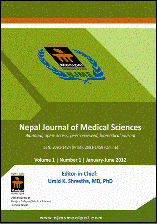The Pattern of Ocular Morbidity, Findings from a Study Conducted in Western Remote Hilly Region of Nepal
DOI:
https://doi.org/10.3126/njms.v1i1.5795Keywords:
Refractive error, dry eyes, ocular allergy, cataractAbstract
Background: There is a lack of study in the pattern of ocular morbidity in western hilly region of Nepal. Therefore a study was carried out to find out the pattern of ocular morbidity, in various age groups in a diagnostic, screening and treatment camp (DST) held in a western hilly remote region of Nepal.
Methods: A descriptive, cross sectional study was done to find out the pattern of ocular morbidity in a western hilly region of Nepal. All the cases included in the study were examined thoroughly from Ophthalmological perspective and a diagnosis was made. Patients needing treatment both medical as well as surgical were advised accordingly and referred when indicated.
Results: A total of 712 eyes of 356 cases were examined in this study. The range of the age varied from two months of life to 91 yrs of age. Age wise most number of cases were in the school going age group accounting for almost 80% of all the cases. The commonest ocular morbidity encountered were refractive error (15.4%), dry eyes, ocular allergy, followed by cataract. Majority of the cases had both dry eyes and ocular allergy. While 70 eyes of 35 patients had no ocular morbidity.
Conclusion: The lower prevalence of age related cataract was due to the extensive cataract surgical coverage provided in the region by various organizations and because of lesser number of cases examined above the age of 40 years. Finding of just three cases of Xerophthalmia (X2B), pointed out towards the success of extensive Vitamin A supplement program run by the ministry of health.
Keywords: Refractive error; dry eyes; ocular allergy; cataract
DOI: http://dx.doi.org/10.3126/njms.v1i1.5795
Nepal Journal of Medical Sciences. 2012; 1(1): 35-38
Downloads
Downloads
How to Cite
Issue
Section
License
Copyright © by Nepal Journal of Medical Sciences. The ideas and opinions expressed by authors of articles summarized, quoted, or published in full text in this Journal represents only opinions of authors and do not necessarily reflect the official policy of Nepal Journal of Medical Sciences or the institute with which the author(s) is (are) affiliated, unless so specified.




